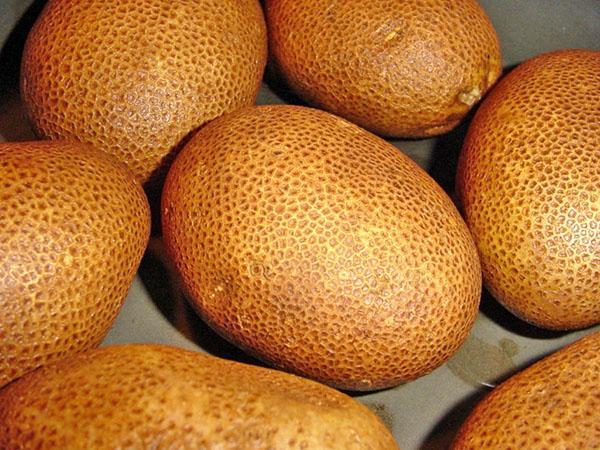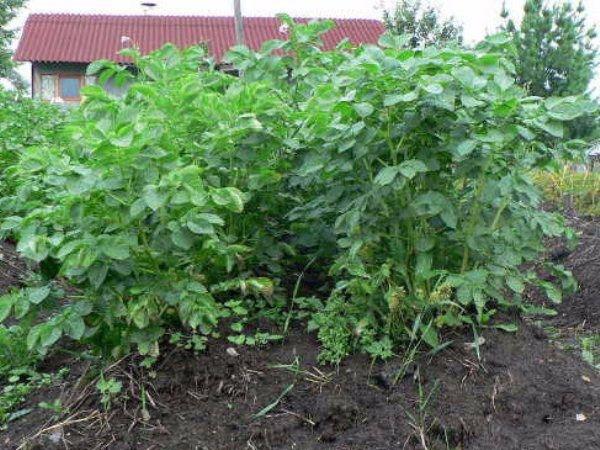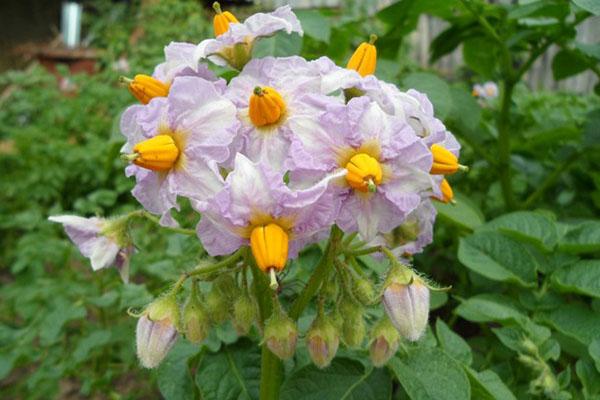Original potatoes of the Kiwi variety: origin and growing rules
 Over the past decades, many new types of vegetables have appeared on the market that have won the hearts of gardeners. However, many are interested in the Kiwi potato, the origin of which raises a number of questions. Some consider it to be a new generation product, derived from genetic engineering. Others radically reject this theory, claiming that the variety was obtained as a result of a simple crossing. Despite the controversy and misunderstandings, enterprising summer residents happily grow the vegetable in their gardens. Let's consider in detail what this unique fruit is.
Over the past decades, many new types of vegetables have appeared on the market that have won the hearts of gardeners. However, many are interested in the Kiwi potato, the origin of which raises a number of questions. Some consider it to be a new generation product, derived from genetic engineering. Others radically reject this theory, claiming that the variety was obtained as a result of a simple crossing. Despite the controversy and misunderstandings, enterprising summer residents happily grow the vegetable in their gardens. Let's consider in detail what this unique fruit is.
The external splendor of the plant

 During the flowering period, light lilac inflorescences appear on the tops of the shoots, which subsequently turn into green balls. A detailed description of the Kiwi potato includes consideration of the fruit. They mature 120 days after planting if weather and climatic conditions favor.
During the flowering period, light lilac inflorescences appear on the tops of the shoots, which subsequently turn into green balls. A detailed description of the Kiwi potato includes consideration of the fruit. They mature 120 days after planting if weather and climatic conditions favor.
 Vegetable tubers have an unusual shape with elongated rounded edges. The peel is thin, reticulate. Feels slightly rough to the touch. The flesh of the product is white in color, although sometimes a brownish tint appears. It is dense enough, therefore, requires long-term heat treatment. During harvest, potato tubers are only large and medium in size. Therefore, the variety is especially appreciated by gardeners.
Vegetable tubers have an unusual shape with elongated rounded edges. The peel is thin, reticulate. Feels slightly rough to the touch. The flesh of the product is white in color, although sometimes a brownish tint appears. It is dense enough, therefore, requires long-term heat treatment. During harvest, potato tubers are only large and medium in size. Therefore, the variety is especially appreciated by gardeners.
Kiwi potatoes: origins and facts
 According to some reports, the vegetable appeared in the Kaluga region. It was bred by amateur breeders in the 1990s. Therefore, the variety is not registered in the state register of plants of the Russian Federation. Also potatoes of this variety have not been scientifically tested.
According to some reports, the vegetable appeared in the Kaluga region. It was bred by amateur breeders in the 1990s. Therefore, the variety is not registered in the state register of plants of the Russian Federation. Also potatoes of this variety have not been scientifically tested.
Despite this, the vegetable is especially popular among gardeners. Most often, the product is grown in the Kuban, as well as in the middle regions of Russia. There is an opinion that Kiwi potatoes are a genetically modified product, therefore they are dangerous to health. However, there is no direct evidence for this. The fact that its foliage is not eaten by the Colorado potato beetle is explained by the presence of a special substance in the foliage. He also scares off the pest from the culture.
The variety got its name due to the similarity with the fruit of the same name: hairy skin and oval shape of the fruit.
Simple rules for growing a crop
 Despite its controversial origin, Kiwi potatoes are quite easy to grow in a summer cottage. To do this, first set the timing of planting, which is influenced by climatic conditions.
Despite its controversial origin, Kiwi potatoes are quite easy to grow in a summer cottage. To do this, first set the timing of planting, which is influenced by climatic conditions.
In the middle regions, the crop is planted in the fields in late April or early May. However, the timing is influenced by:
- weather;
- type of soil in the garden;
- local traditions.
In cooler regions, Kiwi potato planting is postponed until early June. During this period, the land is properly warmed up and ready for the new gardening season.
Since it takes about 120 days for the variety to ripen, it is advisable to calculate in advance the timing of harvesting in your area.
Soil preparation

For the successful cultivation of potatoes, the site is prepared in the fall, which meets the following requirements:
- enough light;
- air throughput;
- lack of shaded areas (trees, fence, building wall);
- convenient access to the beds.
In addition, it is important to provide high-quality soil feeding with the help of:
- manure;
- compost;
- phosphate or potash fertilizers;
- humus.
In the spring, it would be nice to add ash to the soil. If eggplants, peppers or tomatoes have previously grown on the site, then it is better not to use it to grow the plant. Cabbage, pumpkin, legumes and cucumbers.
Landing scheme
 The potatoes of the original Kiwi variety are distinguished by spreading bushes. Therefore, it is planted at a distance of 90 cm from each other. This gives the plant sufficient space and produces large tubers in autumn. The vegetable is planted in holes located at a distance of 75 cm. The wide aisles make it possible to fill up the tubers with high quality, since they are usually not hilled. This approach allows potatoes to grow freely in the garden under the pleasant summer sun and moderate rainfall.
The potatoes of the original Kiwi variety are distinguished by spreading bushes. Therefore, it is planted at a distance of 90 cm from each other. This gives the plant sufficient space and produces large tubers in autumn. The vegetable is planted in holes located at a distance of 75 cm. The wide aisles make it possible to fill up the tubers with high quality, since they are usually not hilled. This approach allows potatoes to grow freely in the garden under the pleasant summer sun and moderate rainfall.
The depth of the planting ridge depends on the nature of the soil. For loamy soil, 8 cm is enough, podzolic and soddy - 10 cm.
Harvesting a bountiful harvest
 As you know, Kiwi potatoes are late-ripening crops. Therefore, it is harvested in late September or early October. A sign of the readiness of a vegetable is the dried bushes of the plant. If weeds grow in the garden, it is advisable to get rid of them. Then proceed to mass harvesting potatoes manually or mechanically.
As you know, Kiwi potatoes are late-ripening crops. Therefore, it is harvested in late September or early October. A sign of the readiness of a vegetable is the dried bushes of the plant. If weeds grow in the garden, it is advisable to get rid of them. Then proceed to mass harvesting potatoes manually or mechanically.
Then the crop is dried directly in the garden or under a canopy in the yard. Potatoes are carefully sorted out, removing rotten and ugly fruits. Quality tubers are placed in the basement for storage... For a long time, the vegetable does not lose its original shape and taste.
 The secret of the Kiwi variety's attractiveness lies in its resistance to diseases and pests. It is almost never attacked by wireworms or Colorado beetles. The surface of the leaf plates has an original roughness and many small hairs. Thanks to this, harmful insects do not sit on them and do not lay eggs. In addition, the variety is resistant to late blight, macrosporiosis and scab.
The secret of the Kiwi variety's attractiveness lies in its resistance to diseases and pests. It is almost never attacked by wireworms or Colorado beetles. The surface of the leaf plates has an original roughness and many small hairs. Thanks to this, harmful insects do not sit on them and do not lay eggs. In addition, the variety is resistant to late blight, macrosporiosis and scab.
Having got acquainted with the origin of the unique potato variety - Kiwi, many appreciated its merits. The ease of growing and harvesting a vegetable allows even inexperienced gardeners to take up a new crop. Why not start the experiment in the new season?